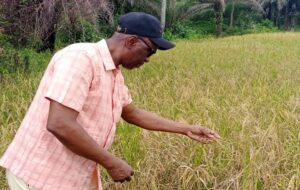By christian.conteh@awokonewspaper.sl
Freetown, SIERRA LEONE- For decades, Amadu Sesay, a farmer from Kailahun in Eastern Sierra Leone, lived in the shadow of poverty. His two hectares of farmland, inherited from his father, yielded just enough to keep his family from going hungry. Each planting season, he would gather indigenous rice seeds saved from the previous harvest, pray for the rains and hope for the best.
But farming in Sierra Leone has never been easy. Poor soil quality, pests, limited access to tools, and outdated farming techniques trapped farmers like Amadu in a cycle of low yields and poverty. “We planted, but the harvest was small. Sometimes we had to buy imported rice just to survive,” Amadu recalls.
Ironically, in a country with abundant fertile land and a rich agricultural history, Sierra Leone imported 430,000 metric tons of rice in 2022, costing the nation an estimated $180 million. This dependency not only drained foreign reserves but also underscored the challenges faced by local farmers.

In 2023, however, Amadu’s life took a dramatic turn, thanks to the Feed Salone initiative, President Julius Maada Bio’s flagship agricultural program. Launched with the ambitious goal of achieving rice self-sufficiency by 2028, the initiative promised farmers a lifeline; a chance to break free from the chains of subsistence farming and transform agriculture into a driver of economic growth.
A Bold National Mission- The Feed Salone initiative, spearheaded by the Ministry of Agriculture and Food Security (MAFS), focused on tackling the bottlenecks in Sierra Leone’s rice value chain. The program introduced high-yield rice seeds, provided mechanized ploughing services, improved access to fertilizers, and distributed modern farming equipment to farmers across the country.
In 2023 alone, the initiative supported 91,982 farmers- 43.7% of whom were women- and increased the area under rice cultivation by 9.5%. This expansion brought the total cultivated area from 554,401 hectares in 2022 to 607,207 hectares in 2023. The result? A remarkable 35.2% increase in harvested paddy, from 947,464 metric tons to 1,280,576 metric tons.
Planting the Seeds of Change- For Amadu, the transformation began with a knock on his door from a local agricultural extension officer. “They told me I could get improved seeds and fertilizers and all I needed was to register,” he says, recalling his initial skepticism. But when he saw the new seeds, developed with international research partners to resist pests and thrive in Sierra Leone’s climate, his doubts began to fade.
A short while after the registration, Amadu received enough seeds to plant two hectares, along with fertilizers rich in nitrogen, phosphorus and potassium. For the first time, he also accessed mechanized ploughing services, which replaced the backbreaking labour of tilling his fields by hand.
By early June, Amadu’s land was planted and ready. The first rains came, and with them, hope. “The plants grew faster and stronger than anything I had ever seen,” he says.
A National Harvest- Amadu’s success was mirrored across the country. Improved seeds and fertilizers, combined with better farming practices, boosted rice yields from 1.9 metric tons per hectare in 2022 to 2.1 metric tons in 2023. Post-harvest losses—a persistent problem for Sierra Leonean farmers, were reduced thanks to new processing equipment, including rice mills with a capacity of 4 metric tons per day.
By the end of the harvest, Amadu’s two hectares yielded over 4.4 metric tons of rice, doubling his previous output. “I sold some of the rice and used the money to buy school supplies for my children,” he says proudly.
Nationally, milled rice production increased from 568,479 metric tons in 2022 to 691,511 metric tons in 2023. This surge in domestic production had a profound impact on rice imports. Between 2022 and mid-2024, imports dropped by over 60%, saving the country millions of dollars.
Challenges and Resilience- Despite these gains, farming in Sierra Leone remains a challenging endeavor. In August 2023, heavy rains flooded parts of Amadu’s farm, threatening to destroy weeks of hard work. “I thought I would lose everything,” he recalls.
But Amadu’s training in climate-smart agriculture, another pillar of the Feed Salone initiative, proved invaluable. By building small drainage systems and raising the height of his rice paddies, he managed to save most of his crop.
Across the country, farmers face similar hurdles, from unpredictable weather to limited infrastructure. Yet, the government’s investments in agricultural infrastructure including 200 kilometers of feeder roads and four rural bridges completed in 2023, are helping to ease these burdens by improving market access and reducing transportation costs.
The Road to Self-Sufficiency – With the rice self-sufficiency rate now at 64% according to official figures from the country’s agriculture ministry, Sierra Leone is on track to close the gap between domestic production and national consumption. The Feed Salone initiative is not just about growing more rice; it’s about transforming the lives of farmers like Amadu.
In 2024, the government supported the cultivation of 27,688 hectares of rice, an 81% increase from 2023. The introduction of agricultural finance instruments, including a $10 million credit facility from the Bank of Sierra Leone, has also enabled farmers to invest in their operations.
A Vision for the Future- Amadu dreams of expanding his farm and employing other farmers from his village. “I want to buy more land and grow enough rice to sell to other countries,” he says.
His dream aligns with the government’s vision. By 2028, Sierra Leone aims to eliminate rice imports entirely and even become a net exporter. Multi-million-dollar projects in irrigation, seed development, and agro-industrial zones are expected to drive this transformation.
For now, Amadu is focused on the next planting season. “Farming is hard work,” he says, “but with the right support, it can change everything.”
His story, and the stories of thousands of farmers like him, underscore the power of resilience, innovation, and strategic government support. While Sierra Leone’s strides in rice production mark a significant step forward, the journey to full self-sufficiency remains a formidable challenge.
The gaps between production and consumption persist, but the achievements of the past year provide a clear and encouraging roadmap for the future. CC/1/1/2025

